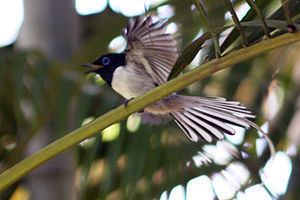Order Passeriformes Genus Terpsiphone Higher classification Paradise flycatcher | Phylum Chordata Family Monarchidae Scientific name Terpsiphone mutata Rank Species | |
 | ||
Similar Paradise flycatcher, Bird, Monarch flycatcher, Passerine, African paradise flycatcher | ||
The Malagasy paradise flycatcher (Terpsiphone mutata) is a species of bird in the family Monarchidae. It is found in Comoros, Madagascar, and Mayotte. Its natural habitats are subtropical or tropical dry forests and subtropical or tropical moist lowland forests.
Contents
Taxonomy and Systematics
When Carl Linnaeus first described the Malagasy paradise flycatcher in 1766, he assigned it to the genus Muscicapa, which contained many of the Old World flycatchers. The species remained in that genus until 1827, when Constantin Wilhelm Lambert Gloger created the genus Terpsiphone for the paradise flycatchers. The genus name Terpsiphone comes from the Greek words terpsi, meaning "delighted in" (from terpo, "to delight") and phone, meaning "voice". The species name, mutata is Latin for "changed" or "different". An alternate common name is the Madagascar paradise flycatcher.
The Malagasy paradise flycatcher is thought to have evolved from African ancestors, as it appears to be more closely related to the African paradise flycatcher than the Indian paradise flycatcher.
Subspecies
There are five subspecies recognized, which differ only slightly in appearance:
Description
The Malagasy paradise flycatcher is a medium-sized passerine, measuring 18 cm (7.1 in) in length and weighing between 12.1 and 12.3 g (0.43 and 0.43 oz). Males have long tail plumes, which can add as much as 18 cm (7.1 in) to their overall length. The female is largely rufous-orange, with a black head and nape. The flight feathers on her wings are black with rufous edges, and she has a thin, light blue eyelid wattle.
Range and habitat
This species is a regional endemic found on Madagascar, Mayotte and the Comoros islands. It is common in all native forest types except montane forest, at elevations ranging from sea level to 1,600 m (5,200 ft). It also occurs, though less frequently, in other wooded habitats, including plantations, gardens and secondary forest.
Food and feeding
Like all members of its genus, the Malagasy paradise flycatcher is an insectivore, feeding on a variety of insects. It regularly joins mixed-species flocks, particularly those containing common newtonias. It is a "follower" in such flocks, allowing other birds to work as "beaters"; it follows them and hunts down any insect prey they flush. Studies have shown that the paradise flycatcher's foraging efficiency is directly correlated to the number of common newtonia in a flock; a greater number of common newtonias results in a higher foraging efficiency for any accompanying Malagasy paradise flycatchers. When rufous vangas, which generally forage within a meter (yard) or so of the ground, are present in the same mixed-species flocks as Malagasy paradise flycatchers, the latter preferentially follow the vangas, and therefore forage closer to the ground than they normally do.
Breeding
The female typically lays a clutch of three eggs measuring 0.72–0.76 inches (18–19 mm) in length and 0.55–0.57 inches (14 mm) in width. These range in color from pinkish-white to salmon-pink, with dense brown or lavender speckling or blotching on the wide end of the egg. This species occasionally serves as host to the Madagascan cuckoo, a brood parasite.
Conservation and threats
The IUCN rates the Malagasy paradise flycatcher as a species of Least Concern. Despite the fact that its numbers appear to be decreasing, the decline is not precipitous, the species is still common on Madagascar and its global range is sizable.
A number of diurnal raptors, including Frances's sparrowhawk, yellow-billed kite and Madagascar harrier-hawk hunt Malagasy paradise flycatchers. In addition, there is at least one record of a common brown lemur eating a nestling Malagasy paradise flycatcher, one of the few records of a wild lemur eating anything other than plant material.
